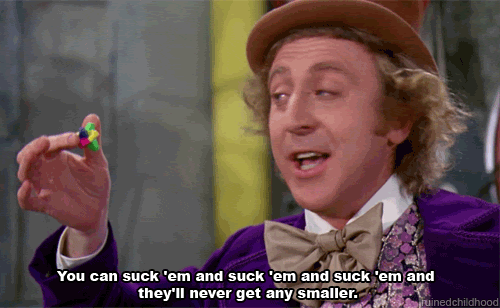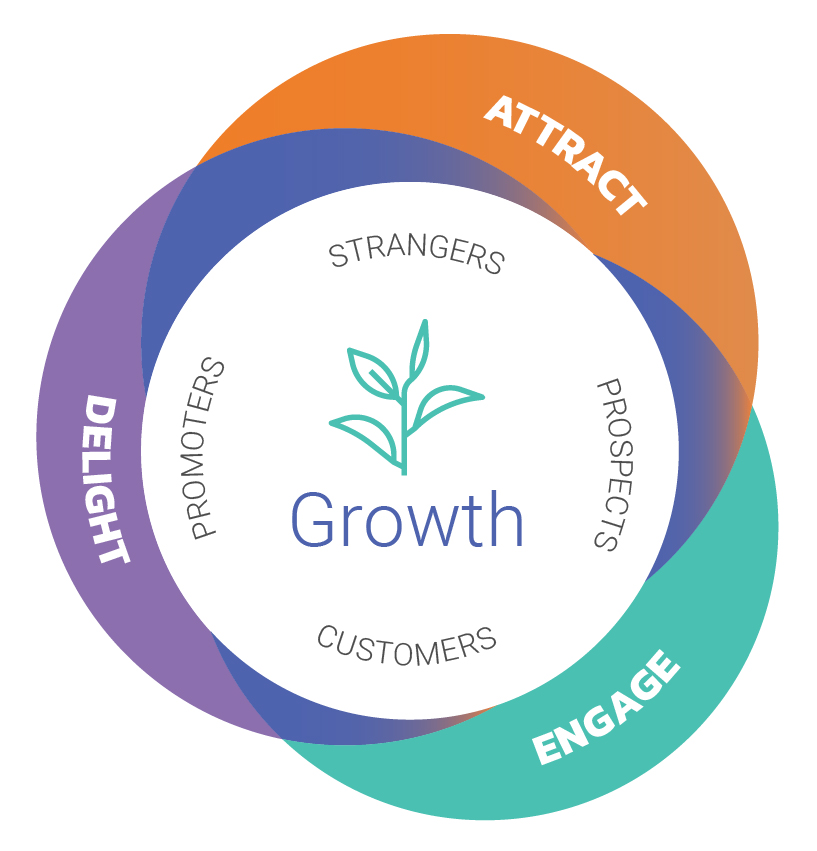3 Changes That Redefined the Marketing Funnel
Over the last several years, the shift in how businesses designed their customers’ journeys has been like going from analog to digital. It started in 2001 when Jeff Bezos first spoke about Amazon’s growth strategy and used the phrase ‘flywheel effect’ to describe the customer-centric business model dubbed the Virtuous Cycle.
After Bezos’ Virtuous Cycle, marketers continued to question the fundamentals of funnels until “new marketing funnels” began popping up over the last two decades, each with a different design and philosophy. Most are similar in approach and placement of the customer within the marketing model. There have also been references to engines, pinball machines, and more when describing these modern marketing funnels.
Before getting into what marketing funnels have become, it’s helpful to first understand why the model changed in the first place.
Companies offered a deeper online experience for their customers simply because they had to.
Consumer experience with ecommerce and digital businesses had, over time, created greater expectations from companies who were forced to face the fact that the customer journey could no longer be a straight shot through the funnel.
As ecommerce and customers adapt, the one-size-fits-all funnel of yesterday has become a narrow and unforgiving pneumatic tube. The basics of the marketing and sales funnel are sound and straightforward, but it’s becoming less and less universally applicable. The issue with the linear model is a twofold fallacy: (1) That only brands can control or initiate communication with customers; and (2) that buying decisions are influenced solely by communication between the consumer and the brand.
The issue with the linear model is a twofold fallacy: (1) That only brands can control or initiate communication with customers; and (2) that buying decisions are influenced solely by communication between the consumer and the brand.
With a more robust online presence, companies have access to a larger number of touchpoints (between brand and consumer) and the onus of utilizing those points of contact is theirs.
It could be an email, a website, an ad, a social media post, or even a customer review. Plenty of marketers use these tools daily. It may be another matter entirely as to whether or not their strategy aligns with the tools, or with the experience customers expect from brands.
Marketing funnels input everything at the top and wait for the output at the end. Like poor Augustus Gloop, consumers were forced in one end of the funnel while marketing and sales stood by, held rapt by the thrill of watching prospects navigate the path laid out for them, all while knowing their final destination was set.
For businesses that moved beyond multichannel marketing, more touchpoints in the customer journey created a revolving door of engagement, turning moments into milestones and re-engaging customers continuously. Only, this new revolving door was two-way and consumers freely engaged with many brands regularly, and often through their fellow consumers.
(That means consumers and brands can both initiate communication and influence buying decisions.)
That’s exactly what consumers and influencers do when they post reviews or unboxing videos. Sure, companies could sponsor influencers to talk about a product or service, but peer-to-peer brand experiences largely exclude the company itself.
Since the first business closures in 2020, both companies and consumers have increased their online presence. Consumers took to review sites and social media to decry poor brand experiences or to sing their praises.

According to Digital Commerce 360, “COVID-19-related boosts in online shopping resulted in an additional $174.87 billion in ecommerce revenue in 2020,” resulting in a total ecommerce sales revenue of $861.12 billion—a number that would not have been reached until 2022 without the pandemic.
The influx of new or improved digital business fronts gave those stuck at home more options. Due to the skepticism many consumers adopted during the COVID-19 pandemic, brands have had to work harder to gain and keep the trust of their target audience despite ecommerce revenue sales.
Customers wanted open communication and hassle-free customer service that didn’t feel like a chore. They wanted cheaper and quicker shipping, and a simpler return/refund process. Individuals didn’t simply demand better features and functions, though.
They needed transparency from companies, which was no surprise as personal values and peer opinion became increasingly integral in the decision making process.
Of course, being on the wrong side of social movements, lacking sincerity, or catching a bad rep for unethical practices can cost brands customers and revenue.
Brands, like most things in life, require proactive maintenance. In 2019-2021, that meant treating every digital touchpoint with the same degree of consideration and intent.
Why?
Whether it’s in the shopping cart or a tweet, any time consumers interact with your brand, it has to be a point of connection and not just contact. Intent behind implementation has to be of benefit to the user. In marketing funnels and multichannel marketing, intent stops at channel creation with loyal customers as the output.
The marketing funnel is about timing and moving customers into and out of the funnel, often with no regard to how the customer experiences each stage.
Now that so much of a brand’s interaction with their audience is online, the expectation is that brands meet consumer expectations at each point of contact in the overall customer journey, whether a company realizes it or not.
It’s these different segments that companies often neglect to include as part of the brand experience; and in relationships, it’s the small things that make the biggest difference.
Providing a feature you didn’t previously is great, but only if that new feature meets expectations and contributes to a positive experience on behalf of the customer.
If a change was made simply to be novel, or made without regard for how it impacts customers, then you risk creating your own fizzy lifting drink (whose recipe is not quite right yet).
A good example of where some companies fail to live up to expectation is responding to online reviews. No one expects companies to respond to every form of review that gets posted online, but how and whether you reply to complaints, negative reviews, and questions will affect how consumers view your brand.
Arguing with a customer on the two-star review they left?
Giving a generic (read: unhelpful) customer service reply that might as well have been an automated spam call?

No matter what brands do, they won’t be able to “please all the people, all of the time;” but making an effort to revolve your efforts around the customer—instead of requiring them to meet you only at certain stages—can be the start of customer-centric marketing.


Regardless of its shape in relation to your business strategy, today’s version of the marketing funnel has to accommodate an omnichannel approach. Omnichannel entails a customer journey model where meaningful connections in all directions—up, down, sideways, slantways, longways, backways, frontways, and squareways—can occur.
Unlike multichannel marketing common in the funnel, customers are placed at the center of the omnichannel model with everything working in concert around them. If older funnel approaches left the customer feeling like Augustus Gloop—an afterthought on his way to the furnace—then an omnichannel method is putting the customer inside the Great Glass Elevator.
That’s the kind of adaptability and personalization that’s possible using an omnichannel approach like the flywheel method.
If your marketing and sales funnel leaves you without a way to account for how brand experiences have evolved or customers sharing their experiences with one another, it’s probably time for a change. To update your marketing efforts and ensure they’re in alignment with your brand’s audience, don’t be afraid to slide into our DMs—contact us!
After Bezos’ Virtuous Cycle, marketers continued to question the fundamentals of funnels until “new marketing funnels” began popping up over the last two decades, each with a different design and philosophy. Most are similar in approach and placement of the customer within the marketing model. There have also been references to engines, pinball machines, and more when describing these modern marketing funnels.
Before getting into what marketing funnels have become, it’s helpful to first understand why the model changed in the first place.
1. The Customer Journey Became Non-Linear
As the world braced itself for mass business closures in 2020, companies and consumers alike turned to the Internet for shopping, services, and more.Companies offered a deeper online experience for their customers simply because they had to.
Consumer experience with ecommerce and digital businesses had, over time, created greater expectations from companies who were forced to face the fact that the customer journey could no longer be a straight shot through the funnel.

As ecommerce and customers adapt, the one-size-fits-all funnel of yesterday has become a narrow and unforgiving pneumatic tube. The basics of the marketing and sales funnel are sound and straightforward, but it’s becoming less and less universally applicable.

With a more robust online presence, companies have access to a larger number of touchpoints (between brand and consumer) and the onus of utilizing those points of contact is theirs.
A touchpoint is defined as any point in the customer journey where a consumer interacts with the brand, its services, or products.
It could be an email, a website, an ad, a social media post, or even a customer review. Plenty of marketers use these tools daily. It may be another matter entirely as to whether or not their strategy aligns with the tools, or with the experience customers expect from brands.
Marketing funnels input everything at the top and wait for the output at the end. Like poor Augustus Gloop, consumers were forced in one end of the funnel while marketing and sales stood by, held rapt by the thrill of watching prospects navigate the path laid out for them, all while knowing their final destination was set.

For businesses that moved beyond multichannel marketing, more touchpoints in the customer journey created a revolving door of engagement, turning moments into milestones and re-engaging customers continuously. Only, this new revolving door was two-way and consumers freely engaged with many brands regularly, and often through their fellow consumers.
2. Customers Demanded More From Brands
Reviews are largely to give consumers greater advocacy in their buying experience, but they also provide public credibility to brands that serve as social proof to other would-be customers.(That means consumers and brands can both initiate communication and influence buying decisions.)
That’s exactly what consumers and influencers do when they post reviews or unboxing videos. Sure, companies could sponsor influencers to talk about a product or service, but peer-to-peer brand experiences largely exclude the company itself.

Since the first business closures in 2020, both companies and consumers have increased their online presence. Consumers took to review sites and social media to decry poor brand experiences or to sing their praises.

According to Digital Commerce 360, “COVID-19-related boosts in online shopping resulted in an additional $174.87 billion in ecommerce revenue in 2020,” resulting in a total ecommerce sales revenue of $861.12 billion—a number that would not have been reached until 2022 without the pandemic.
The influx of new or improved digital business fronts gave those stuck at home more options. Due to the skepticism many consumers adopted during the COVID-19 pandemic, brands have had to work harder to gain and keep the trust of their target audience despite ecommerce revenue sales.
Customers wanted open communication and hassle-free customer service that didn’t feel like a chore. They wanted cheaper and quicker shipping, and a simpler return/refund process. Individuals didn’t simply demand better features and functions, though.

They needed transparency from companies, which was no surprise as personal values and peer opinion became increasingly integral in the decision making process.
3. The Brand Experience Was Evolving
There’s been no shortage of businesses opening up about their aspirations, the ways in which they give back, or their impact on the world and environment. The social movements brands choose to participate in create a personable context consumers can relate to, making the faceless brand a bit more human.Of course, being on the wrong side of social movements, lacking sincerity, or catching a bad rep for unethical practices can cost brands customers and revenue.
Brands, like most things in life, require proactive maintenance. In 2019-2021, that meant treating every digital touchpoint with the same degree of consideration and intent.
Why?
Whether it’s in the shopping cart or a tweet, any time consumers interact with your brand, it has to be a point of connection and not just contact. Intent behind implementation has to be of benefit to the user. In marketing funnels and multichannel marketing, intent stops at channel creation with loyal customers as the output.
The marketing funnel is about timing and moving customers into and out of the funnel, often with no regard to how the customer experiences each stage.

Now that so much of a brand’s interaction with their audience is online, the expectation is that brands meet consumer expectations at each point of contact in the overall customer journey, whether a company realizes it or not.
It’s these different segments that companies often neglect to include as part of the brand experience; and in relationships, it’s the small things that make the biggest difference.

Providing a feature you didn’t previously is great, but only if that new feature meets expectations and contributes to a positive experience on behalf of the customer.
If a change was made simply to be novel, or made without regard for how it impacts customers, then you risk creating your own fizzy lifting drink (whose recipe is not quite right yet).

A good example of where some companies fail to live up to expectation is responding to online reviews. No one expects companies to respond to every form of review that gets posted online, but how and whether you reply to complaints, negative reviews, and questions will affect how consumers view your brand.
Arguing with a customer on the two-star review they left?

Giving a generic (read: unhelpful) customer service reply that might as well have been an automated spam call?

No matter what brands do, they won’t be able to “please all the people, all of the time;” but making an effort to revolve your efforts around the customer—instead of requiring them to meet you only at certain stages—can be the start of customer-centric marketing.
What Today’s Marketing Funnel Looks Like
Contemporary takes on the old-school funnel look more like a flywheel that promotes an overall holistic, customer-focused philosophy. It makes “client-facing” common parlance among internal teams so that each one understands where, when, why, and how their contributions affect the customer experience.

Regardless of its shape in relation to your business strategy, today’s version of the marketing funnel has to accommodate an omnichannel approach. Omnichannel entails a customer journey model where meaningful connections in all directions—up, down, sideways, slantways, longways, backways, frontways, and squareways—can occur.

Unlike multichannel marketing common in the funnel, customers are placed at the center of the omnichannel model with everything working in concert around them. If older funnel approaches left the customer feeling like Augustus Gloop—an afterthought on his way to the furnace—then an omnichannel method is putting the customer inside the Great Glass Elevator.
That’s the kind of adaptability and personalization that’s possible using an omnichannel approach like the flywheel method.
If your marketing and sales funnel leaves you without a way to account for how brand experiences have evolved or customers sharing their experiences with one another, it’s probably time for a change. To update your marketing efforts and ensure they’re in alignment with your brand’s audience, don’t be afraid to slide into our DMs—contact us!
